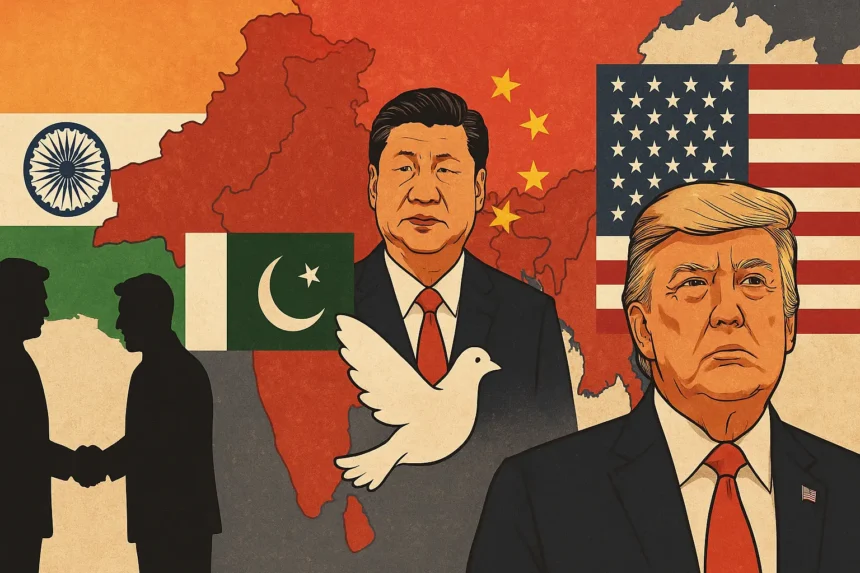China’s Ceasefire Gamble Fails: How the US Blocked Beijing’s South Asia Game Plan
In a surprising twist of diplomacy, China’s subtle strategy to leverage the India-Pakistan ceasefire for political and economic gain has hit a wall—and it’s the United States that slammed the brakes.
Let’s dive into how this all played out, why China was so eager to jump in, and how the U.S. move changes the dynamics of South Asia and global investor sentiment.
1. The Perfect Storm: India-Pakistan Tensions Gave China an Opening
Whenever India and Pakistan clash, the tremors are felt far beyond the border. For China, these moments present golden opportunities. Why? Because instability between New Delhi and Islamabad gives Beijing a perfect excuse to step in as a “peace-broker“—a soft-power tactic to expand its footprint in South Asia.
China has been itching to gain leverage in the region, especially with its ongoing investments in Pakistan under the China-Pakistan Economic Corridor (CPEC)—a $60 billion initiative that aims to boost connectivity from China’s Xinjiang to Pakistan’s Gwadar port.
Had the conflict escalated, China could’ve used its diplomatic intervention as a stepping stone to deeper economic influence.
2. The U.S. Steps In—and Derails China’s Plans
But before China could roll out its influence playbook, the U.S. swooped in. President Donald Trump made a bold announcement: both India and Pakistan had agreed to an immediate ceasefire. It wasn’t just about peace—it was a strategic move that denied China the spotlight.
America’s mediation shut the door on China’s ambitions to position itself as the key power broker in South Asia.
This wasn’t just about conflict resolution—it was geopolitical chess.
3. China’s Regional Rivalry and the Trade War Angle
China is already locked in a trade war with the U.S., and its global image is under scrutiny. Meanwhile, India continues to rise as a regional economic superpower, attracting investments that would otherwise go to China.
Beijing sees India as a long-term threat—a rival that could eventually challenge its position as Asia’s economic engine. Conflict between India and Pakistan weakens investor confidence in India, which plays right into China’s hands.
But the ceasefire changed the game. It signaled stability in South Asia, which is good news for investors—and bad news for China.
4. Investor Sentiment and Market Reactions
Interestingly, financial markets didn’t panic during the brief period of border tensions. Experts believed there was little chance of a full-blown war. The rupee remained stable, and even bond yields normalized quickly after a minor uptick.
Compare that to June 2020, when Indian and Chinese troops clashed in the Galwan Valley. The rupee dipped by 1%, but quickly recovered after de-escalation.
In short, investors are watching—but not overreacting.
5. India’s Growth Story Threatens China’s Position
India’s Economic Momentum at a Glance
To better understand India’s impressive growth trajectory and its emerging role on the global stage, here’s a quick snapshot of key economic indicators and strategic developments:
| India’s economy is projected to grow at 6.5%, making it one of the fastest-growing economies globally. | Since April, the Nifty50 index has gained 4.6%. |
| Foreign investors have returned strongly, buying nearly $1.5 billion in Indian equities. | India finalized a trade deal with the UK and is progressing in talks with the U.S. |
| India is emerging as a reliable alternative to China in supply chains and global investment strategies. | The return of foreign capital indicates strong global confidence in India’s economic stability. |
For Beijing, this is troubling. Stability in India means accelerated growth. And growth means competition.
The Ceasefire’s Hidden Message: Stability Wins
China wanted to exploit instability, but the swift U.S.-led ceasefire proved that peace is more powerful than posturing. It showed global markets and allies that India is not a flashpoint but a pillar of stability in the region.
That message matters—for trade deals, for diplomatic ties, and for investment confidence.
Final Thoughts: China’s Missed Moment is India’s Gain
China stood to benefit significantly from prolonged tensions between India and Pakistan. Such instability could have allowed Beijing to position itself as a key mediator in South Asia, boosting its political clout and deepening its economic influence, especially through initiatives like the China-Pakistan Economic Corridor (CPEC).
However, the United States intervened at a critical moment, brokering a ceasefire and effectively derailing China’s strategic opportunity. This timely move not only neutralized Beijing’s ambitions but also sent a strong signal to global markets about India’s resilience and diplomatic maturity. As a result, investor confidence in India remained intact, with its economy continuing to attract foreign capital and forge new trade partnerships.
The U.S. action reinforced India’s image as a reliable partner and a rising economic powerhouse, undermining China’s narrative and strengthening the broader Indo-Pacific strategy. The ceasefire not only calmed regional tensions but also reshaped geopolitical dynamics in India’s favor.
The result?
- A blow to China’s ambitions
- A win for South Asian peace
- A green light for investors eyeing India
Want to read more on South Asia’s rising influence and global power shifts?
Subscribe now.
Most read: https://tnheadlines24.com/469-cr-lost-furious-indians-boycott-turkey/
Disclaimer: The views and opinions expressed in this article are for informational purposes only and do not constitute official advice or endorsement. TN HEADLINES24 is not responsible for the accuracy, completeness, or reliability of any information provided. Readers are advised to verify facts independently and use their own judgment before making any decisions based on this content.








